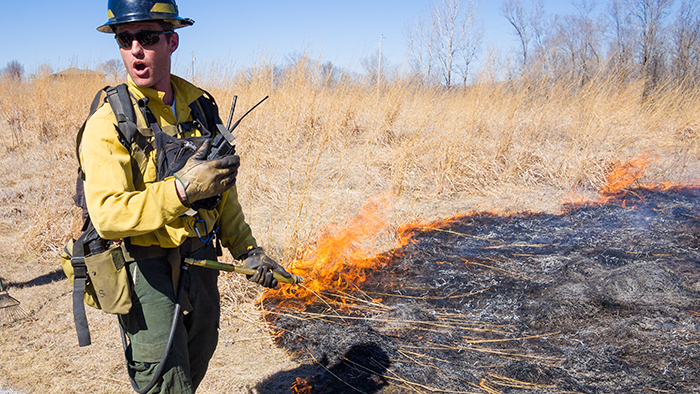… Professor Christoph Geiss went to scenic Iowa – western Iowa to be precise. Christoph spent a long weekend at Hitchcock Nature Center in Honey Creek, Iowa.
While many of you got roasted on the beach, Christoph took his field training to study wildfires and become a wildland firefighter. The training started out pretty benign. The class learned about equipment (expensive!), life on the fireline and in fire camp (dirty – no showers for a week), and how to use the various hand tools. The highlight of the morning was a fire shelter exercise: Christoph and his fellow firefighter rookies had exactly 30 seconds to unpack a fire shelter, climb into it and drop to the ground (feet to the assumed fire). The exercise was fun, the re-folding of the practice shelters less so. They seemed to get bigger after every drill.

Yep, that’s the class under practice fire shelters. The real thing is made of some space-age fiberglass-aluminum composite, weighs a ton and costs even more. We were only allowed to play with the practice version. The guy in the flannel shirt shakes every shelter to simulate the fierce winds to be expected during a fire storm.
The afternoon was spent on fire fighting tactics and safety (Always keep an eye out for your safety zone and establish a solid anchor point!). The class also got to spray some water as they learned about the ins- and outs of fire engines, hose lays and various nozzles.
The highlight of the afternoon came after a short hike (in formation, spaced 10 ft apart, tool held on the side at the balance point on the (non-existing) downhill side – no swinging, hacking or stabbing allowed) to a nearby tallgrass prairie. The big bluestem burned quite nicely and provided just enough excitement.
The group practiced on several small fires. It took the instructors maybe a minute to extinguish theirs, the class was, well, not quite as practiced, but after a few (very) hot hours everybody had three little grass fires under their belts, and knew how to “enter the fire from the heel”, work “from the black”, and learned that a simple backpack pump can do wonders, but that even 4-ft flames put out quite a bit of heat.
Christoph also used the opportunity to sample some recently burned soils, go on a few hikes and watched the pro’s extinguish a “real” grass fire, where he learned that the mighty backpack pump may well be an effective fire-fighting tool, but that even a measly “Type 6” fire engine puts out so much more water…












